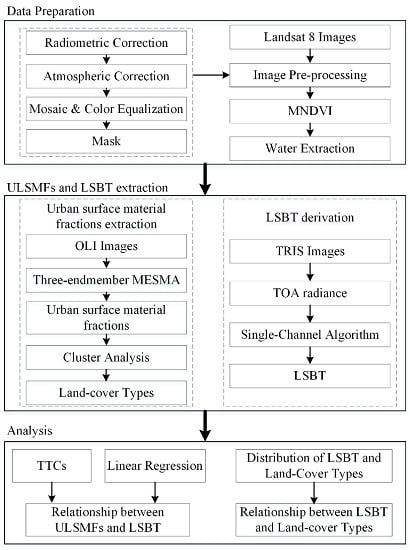The Relationship between Urban Land Surface Material Fractions and Brightness Temperature Based on MESMA
Abstract
:1. Introduction
2. Materials and Methods
2.1. Study Area and Data Preprocessing
2.2. Methodology
2.2.1. Urban Land Surface Material Fractions on the Basis of MESMA
2.2.2. Land Surface Brightness Temperature Derivation
2.2.3. Ternary Triangular Chart
3. Results
3.1. Distribution of Endmember Fractions
3.2. Aestival LSBT Distribution
3.3. Relationship between ULSMFs and LSBT
4. Discussion
5. Conclusions
Acknowledgments
Author Contributions
Conflicts of Interest
Abbreviations
| CCCD | Continuous Classification and Change Detection |
| LSBT | Land Surface Brightness Temperature |
| LSMA | Linear Spectral Mixture Analysis |
| MESMA | Multiple Endmember Spectral Mixture Analysis |
| MNDWI | Modified Normalized Difference Water Index |
| NDVI | Normalized Difference Vegetation Index |
| OBIA | Object-based Image Analysis |
| TTC | Ternary Triangular Chart |
| ULSMFs | Urban Land Surface Material Fractions |
| UTM | Universal Transverse Mercator |
| VIPER | Visualization and Image Processing for Environmental Research |
References
- Chen, X.L.; Zhao, H.M.; Li, P.X.; Yin, Z.Y. Remote sensing image-based analysis of the relationship between urban hear island and land use/cover changes. Remote Sens. Environ. 2006, 104, 133–146. [Google Scholar] [CrossRef]
- Xia, J.; Du, P.; Zhang, H.; Liu, P. The quantitative relationship between land surface temperature and land cover types based on remotely sensed data. Remote Sens. Technol. Appl. 2010, 25, 15–23, (In Chinese with English Abstract). [Google Scholar]
- Tian, P.; Tian, G.; Wang, F.; Wang, Y.F. Urban heat island effect and vegetation cover index relation using Landsat TM image. Bull. Sci. Technol. 2006, 22, 708–713, (In Chinese with English Abstract). [Google Scholar]
- Zhou, H.M.; Zhou, C.H.; Ge, W.Q.; Ding, J.C. The surveying on thermal distribution in urban based on GIS and remote sensing. Acta Geogr. Sin. 2001, 56, 189–197, (In Chinese with English Abstract). [Google Scholar]
- Chen, Y.; Wang, J.; Li, X. A study on urban thermal field in summer based on satellite remote sensing. Remote Sens. Land Resour. 2002, 14, 55–59, (In Chinese with English Abstract). [Google Scholar]
- Li, X.X.; Myint, S.W.; Zhang, Y.; Galletti, C.; Zhang, X.; Turner, B.L. Object-based land-cover classification for metropolitan Phoenix, Arizona, using aerial photography. Int. J. Appl. Earth Obs. Geoinf. 2014, 33, 321–330. [Google Scholar] [CrossRef]
- Li, X.X.; Li, W.W.; Middel, A.; Harlan, S.L.; Brazel, A.J.; Turner, B.L. Remote sensing of the surface urban heat island and land architecture in Phoenix, Arizona: Combined effects of land composition and configuration and cadastral-demographic-economic factors. Remote Sens. Environ. 2016, 174, 233–243. [Google Scholar] [CrossRef]
- Zhu, Z.; Woodcock, C.E. Continuous change detection and classification of land cover using all available Landsat data. Remote Sens. Environ. 2014, 144, 152–171. [Google Scholar] [CrossRef]
- Fu, P.; Weng, Q. A time series analysis of urbanization induced land use and land cover change and its impact on land surface temperature with Landsat imagery. Remote Sens. Environ. 2016, 175, 205–214. [Google Scholar] [CrossRef]
- Michishita, R.; Jiang, Z.B.; Xu, B. Monitoring two decades of urbanization in the Poyang Lake area, China through spectral unmixing. Remote Sens. Environ. 2012, 117, 3–18. [Google Scholar] [CrossRef]
- Lu, D.S.; Moran, E.; Batistelia, M. Linear mixture model applied to Amazonian vegetation classification. Remote Sens. Environ. 2003, 87, 456–469. [Google Scholar] [CrossRef]
- Phinn, S.; Stanford, M.; Scarth, P. Monitoring the composition of urban environments based on the vegetation-impervious surface-soil (VIS) model by subpixel analysis techniques. Remote Sens. Environ. 2002, 23, 4131–4153. [Google Scholar] [CrossRef]
- Roberts, D.A.; Gardner, M.; Church, R.; Ustin, S.; Scheer, G.; Green, R.O. Mapping Chaparral in the Santa Monica Mountains Using Multiple Endmember Spectral Mixture Models. Remote Sens. Environ. 1998, 65, 267–279. [Google Scholar] [CrossRef]
- Quintano, C.; Fernández-Manso, A.; Roberts, D.A. Multiple Endmember Spectral Mixture Analysis (MESMA) to map burn severity levels from Landsat images in Mediterranean countries. Remote Sens. Environ. 2013, 136, 76–88. [Google Scholar] [CrossRef]
- Quintano, C.; Fernandez-Manso, A.; Roberts, D.A. Burn severity mapping from Landsat MESMA fraction images and Land Surface Temperature. Remote Sens. Environ. 2017, 190, 83–95. [Google Scholar] [CrossRef]
- Zhang, Z.M.; He, G.J.; Dai, Q.; Jiang, H. Leaf Area Index Estimation Using MESMA Based on EO-1 Hyperion Satellite Imagery. Int. J. Inf. Electron. Eng. 2014, 4, 11–15. [Google Scholar] [CrossRef]
- Zhang, M.; Huang, S.; Feng, W. Further calculating plots in a triangle for the classification of sandstones. J. Chengdu Univ. Technol. Sci. Technol. Ed. 2005, 32, 421–429. [Google Scholar]
- Arnone, R.; Loisel, H.; Carder, K.; Boss, E.; Maritorena, S.; Lee, Z. Remote Sensing of Inherent Optical Properties: Fundamentals, Tests of Algorithms, and Applications; IOCCG Report 2006; International Ocean-Colour Coordinating Group: Hanover, NH, USA, 2006; Volume 5, pp. 95–100. [Google Scholar]
- Uitz, J.; Stramski, D.; Reynolds, R.A.; Dubranna, J. Assessing phytoplankton community composition from hyperspectral measurements of phytoplankton absorption coefficient and remote-sensing reflectance in open-ocean environments. Remote Sens. Environ. 2015, 171, 58–74. [Google Scholar] [CrossRef]
- Xin, X.; Zhang, P. Vulnerability classification in man-land territorial system of mining cities based on triangle methodology. J. China Coal Soc. 2009, 34, 284–288, (In Chinese with English Abstract). [Google Scholar]
- Xu, F.; Zhao, S.; Zhang, Y.; Hao, J.; Zhan, W. A methodology for evaluating quantitatively the sustainability status and trends of economic development. Acta Sci. Circumst. 2005, 25, 711–720, (In Chinese with English Abstract). [Google Scholar]
- Wu, H.; Ye, L.P.; Shi, W.Z.; Clarke, K.C. Assessing the effects of land use spatial structure on urban heat islands using HJ-1B remote sensing imagery in Wuhan, China. Int. J. Appl. Earth Obs. Geoinf. 2014, 32, 67–78. [Google Scholar] [CrossRef]
- Makarau, A.; Richter, R.; Schläpfer, D.; Reinartz, P. Combined haze and cirrus removal for multispectral imagery. IEEE Geosci. Remote Sens. Lett. 2016, 13, 379–383. [Google Scholar] [CrossRef]
- Roberts, D.A.; Smith, M.O.; Adams, J.B. Green vegetation, nonphotosynthetic vegetation, and soils in AVIRIS data. Remote Sens. Environ. 1993, 44, 255–269. [Google Scholar] [CrossRef]
- Fan, F.; Deng, Y. Enhancing endmember selection in multiple endmember spectral mixture analysis (MESMA) for urban impervious surface area mapping using spectral angle and spectral distance parameters. Int. J. Appl. Earth Obs. Geoinf. 2014, 33, 290–301. [Google Scholar] [CrossRef]
- Roberts, D.A.; Dennison, P.E.; Gardner, M.E.; Hetzel, Y. Evaluation of the potential of Hyperion for fire danger assessment by comparison to the Airborne Visible/Infrared Imaging Spectrometer. IEEE Trans. Geosci. Remote Sens. 2003, 41, 1297–1310. [Google Scholar] [CrossRef]
- Dennison, P.E.; Roberts, D.A. Endmember selection for multiple endmember spectral mixture analysis using endmember average RMSE. Remote Sens. Environ. 2003, 87, 123–135. [Google Scholar] [CrossRef]
- Dennison, P.E.; Halligan, K.Q.; Roberts, D.A. A comparison of error metrics and constraints for multiple endmember spectral mixture analysis and spectral angle mapper. Remote Sens. Environ. 2004, 93, 359–367. [Google Scholar] [CrossRef]
- Vassilopoulou, V.; Katsanevakis, S.; Panayotidis, P.; Anagnostou, C.; Damalas, D.; Dogrammatzi, A.; Drakopoulou, V.; Giakoumi, S.; Haralabous, J.; Issaris, Y.; et al. Application of the MESMA Framework. Case Study: Inner Ionian Archipelago & Adjacent Gulfs. 2012. Available online: http://www.mesma.org/FILE_DIR/06-10-2013_13-42-31_16_3_MESMA-FW-Case-Study-Greece.pdf (accessed on 25 May 2017).
- Ozelkan, E.; Bagis, S.; Ozelkan, E.C.; Ustundag, B.B.; Ormeci, C. Land Surface Temperature Retrieval for Climate Analysis and Association with Climate Data. Eur. J. Remote Sens. 2014, 47, 655–669. [Google Scholar] [CrossRef]
- Feizizadeh, B.; Blaschke, T. Examining urban heat island relations to land use and air pollution: Multiple endmember spectral mixture analysis for thermal remote sensing. IEEE J. Sel. Top. Appl. Earth Obs. Remote Sens. 2013, 6, 1749–1756. [Google Scholar] [CrossRef]
- Dash, P.; Göttsche, F.M.; Olesen, F.S.; Fischer, H. Land surface temperature and emissivity estimation from passive sensor data: Theory and practice-current trends. Int. J. Remote Sens. 2002, 23, 2563–2594. [Google Scholar] [CrossRef]
- Pareeth, S.; Salmaso, N.; Adrian, R.; Neteler, M. Homogenised daily lake surface water temperature data generated from multiple satellite sensors: A long-term case study of a large sub-Alpine lake. Sci. Rep. 2016, 6, 31251. [Google Scholar] [CrossRef] [PubMed]
- Yu, X.; Guo, X.; Wu, Z. Land surface temperature retrieval form Landsat 8 TIRS—Comparison between radiative transfer equation based method, split window algorithm and single channel method. Remote Sens. 2014, 6, 9829–9852. [Google Scholar] [CrossRef]
- Coll, C.; Galve, J.M.; Sanchez, J.M.; Caselles, V. Validation of Landsat-7/ETM+ Thermal-Band Calibration and Atmospheric Correction with Ground-Based Measurements. IEEE Trans. Geosci. Remote Sens. 2010, 48, 547–555. [Google Scholar] [CrossRef]
- Chander, G.; Markham, B.L.; Helder, D.L. Summary of current radiometric calibration coefficients for Landsat MSS, TM, ETM+, and EO-1 ALI sensors. Remote Sens. Environ. 2009, 113, 893–903. [Google Scholar] [CrossRef]
- Ridd, M.K. Exploring a VIS (vegetation-impervious surface-soil) model for urban ecosystem analysis through remote sensing: Comparative anatomy for cities. Int. J. Remote Sens. 1995, 16, 2165–2185. [Google Scholar] [CrossRef]
- Xu, H. Modification of normalized difference water index (NDWI) to enhance open water features in remotely sensed imagery. Int. J. Remote Sens. 2006, 27, 3025–3033. [Google Scholar] [CrossRef]
- Sheng, Y.W.; Song, C.Q.; Wang, J.D.; Lyons, E.A.; Knox, B.R.; Cox, J.S.; Gao, F. Representative lake water extent mapping at continental scales using multi-temporal Landsat-8 imagery. Remote Sens. Environ. 2016, 185, 129–141. [Google Scholar] [CrossRef]
- Celebi, M.E.; Kingravi, H.A.; Vela, P.A. A comparative study of efficient initialization methods for the k-means clustering algorithm. Expert Syst. Appl. 2013, 40, 200–210. [Google Scholar] [CrossRef]
- Field, A. Discovering Statistics Using IBM SPSS Statistics, 4th ed.; Sage Publications Ltd.: Los Angeles, CA, USA, 2013. [Google Scholar]
- Gouveia, C.M.; Trigo, R.M.; Beguería, S.; Vicente-Serrano, S.M. Drought impacts on vegetation activity in the Mediterranean region: An assessment using remote sensing data and multi-scale drought indicators. Glob. Planet. Chang. 2016. [Google Scholar] [CrossRef]
- Zhang, Y.; Li, Z. Remote sensing of atmospheric fine particulate matter (PM2.5) mass concentration near the ground from satellite observation. Remote Sens. Environ. 2015, 160, 252–262. [Google Scholar] [CrossRef]
- Asmala, A.; Shaun, Q. Haze modelling and simulation in remote sensing satellite data. Appl. Math. Sci. 2014, 8, 7909–7921. [Google Scholar]
- Zhang, Z.; Zhang, X.; Gong, D.; Kim, S.J.; Mao, R.; Zhao, X. Possible influence of atmospheric circulations on winter haze pollution in the Beijing–Tianjin–Hebei region, northern China. Atmos. Chem. Phys. 2016, 16, 561–571. [Google Scholar] [CrossRef]
- Wang, H.; Chen, H. Understanding the recent trend of haze pollution in eastern China: Roles of climate change. Atmos. Chem. Phys. 2016, 16, 4205–4211. [Google Scholar] [CrossRef]
- Tian, M.; Wang, H.B.; Chen, Y.; Yang, F.M.; Zhang, X.H.; Zou, Q.; Zhang, R.Q.; Ma, Y.L.; He, K.B. Characteristics of aerosol pollution during heavy haze events in Suzhou, China. Atmos. Chem. Phys. 2015, 15, 33407–33443. [Google Scholar] [CrossRef]
- Johnson, R.A.; Wichern, D.W. Applied Multivariate Statistical Analysis, 6th ed.; Prentice Hall: Upper Saddle River, NJ, USA, 2002. [Google Scholar]
- Souza, J.B.D.; Santos, J.M. Principal Components and generalized linear modeling inthe correlation between hospital admissions and air pollution. Rev. Saúde Pública 2014, 48, 451–458. [Google Scholar] [CrossRef] [PubMed]
- Recio-Vazquez, L.; Almendros, G.; Knicker, H.; Carral, P.; Álvarez, A.M. Multivariate statistical assessment of functional relationships between soil physical descriptors and structural features of soil organic matter in Mediterranean ecosystems. Geoderma 2014, 230–231, 95–107. [Google Scholar] [CrossRef]
- Wang, C.; Myint, S.W.; Wang, Z.; Song, J. Spatio-temporal modeling of the urban heat island in the Phoenix metropolitan area: Land use change implications. Remote Sens. 2016, 8, 185. [Google Scholar] [CrossRef]
- Myint, S.W.; Wentz, E.A.; Brazel, A.J.; Quattrochi, D.A. The impact of distinct anthropogenic and vegetation features on urban warming. Landsc. Ecol. 2013, 28, 959–978. [Google Scholar] [CrossRef]
- Zheng, B.; Myint, S.W.; Fan, C. Spatial configuration of anthropogenic land cover impacts on urban warming. Landsc. Urban Plan. 2014, 130, 104–111. [Google Scholar] [CrossRef]
- Weng, Q. A remote sensing-GIS evaluation of urban expansion and its impact on surface temperature in the Zhujiang Delta, China. Int. J. Remote Sens. 2001, 22, 1999–2014. [Google Scholar] [CrossRef]
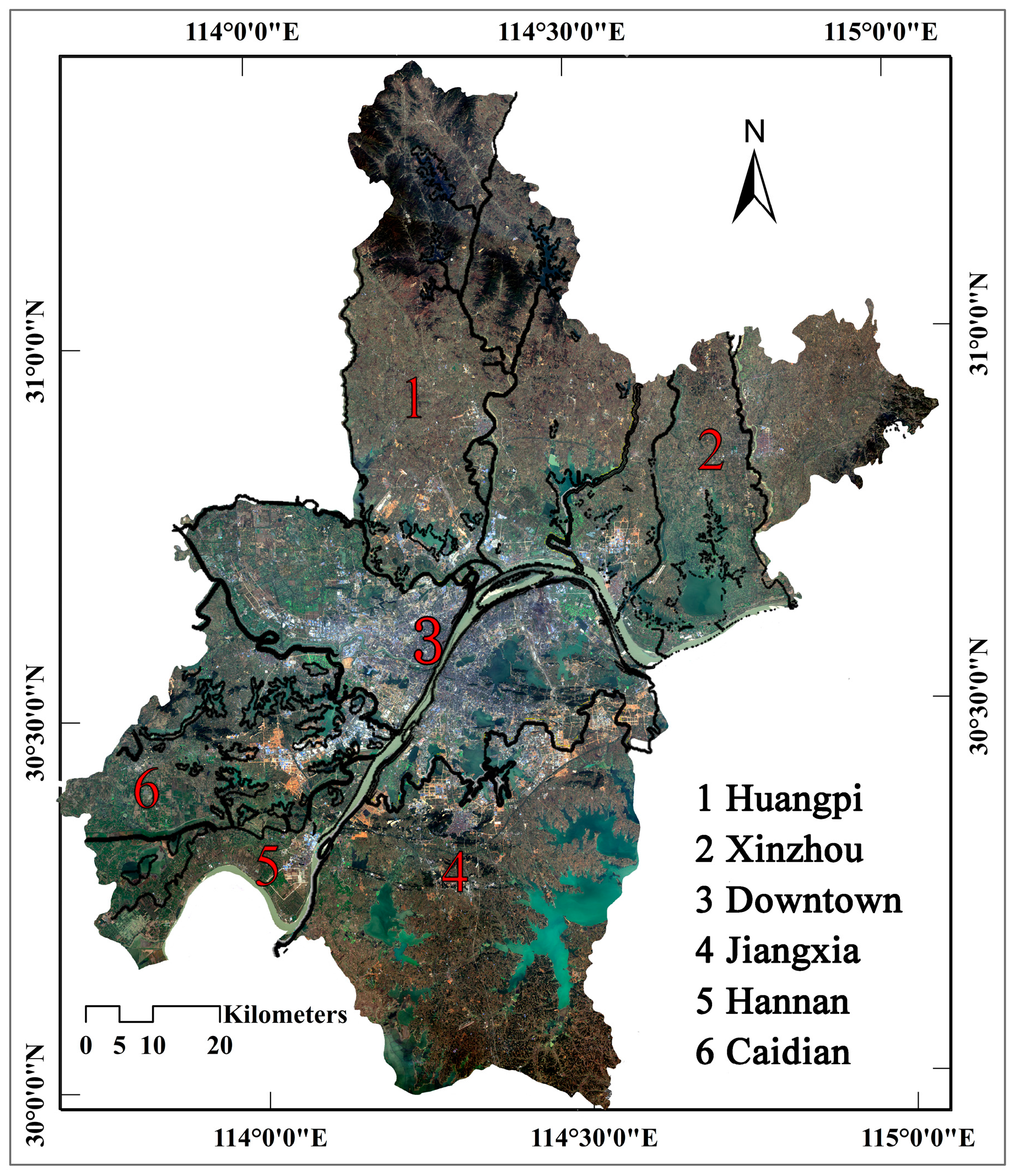
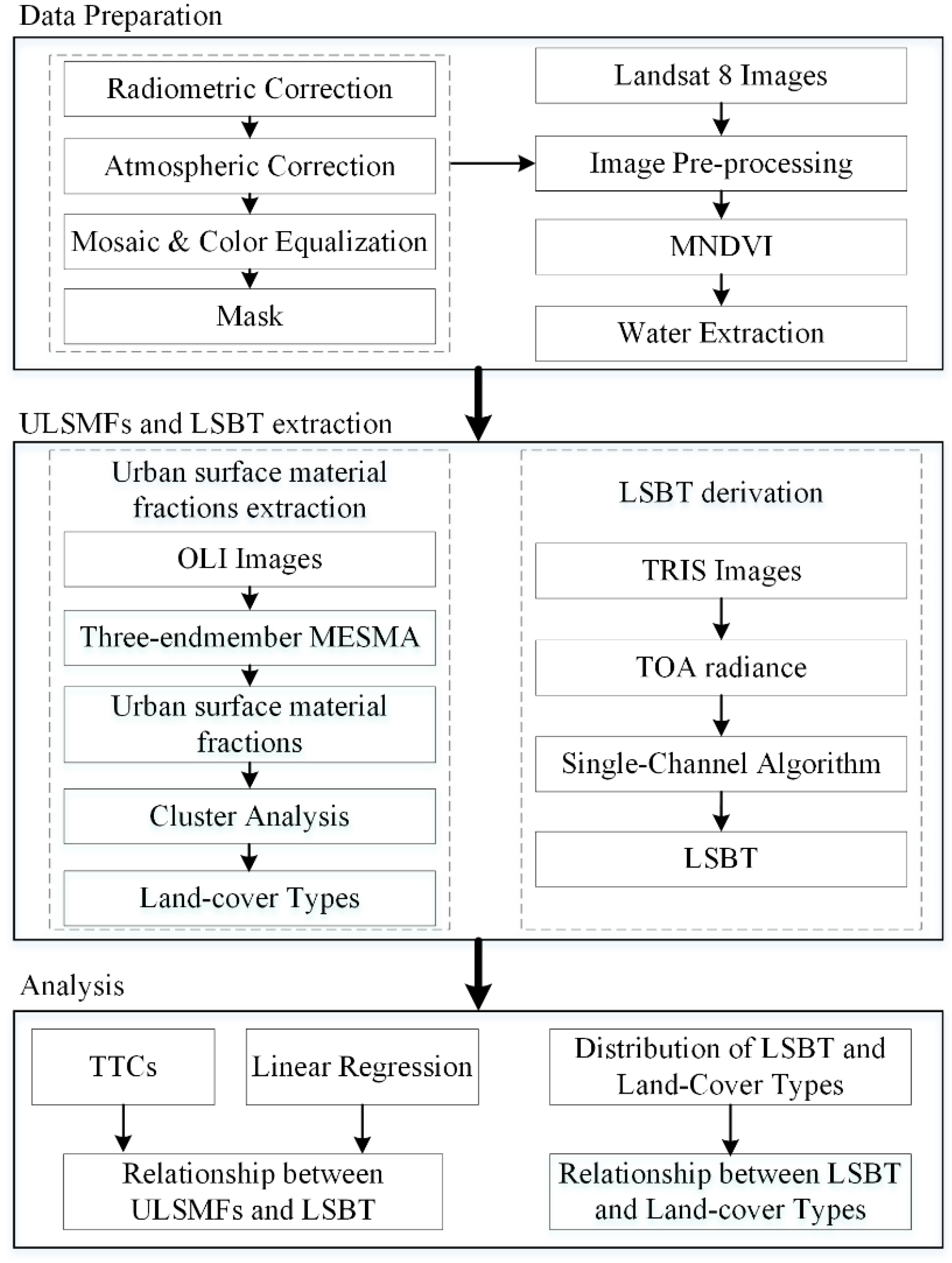
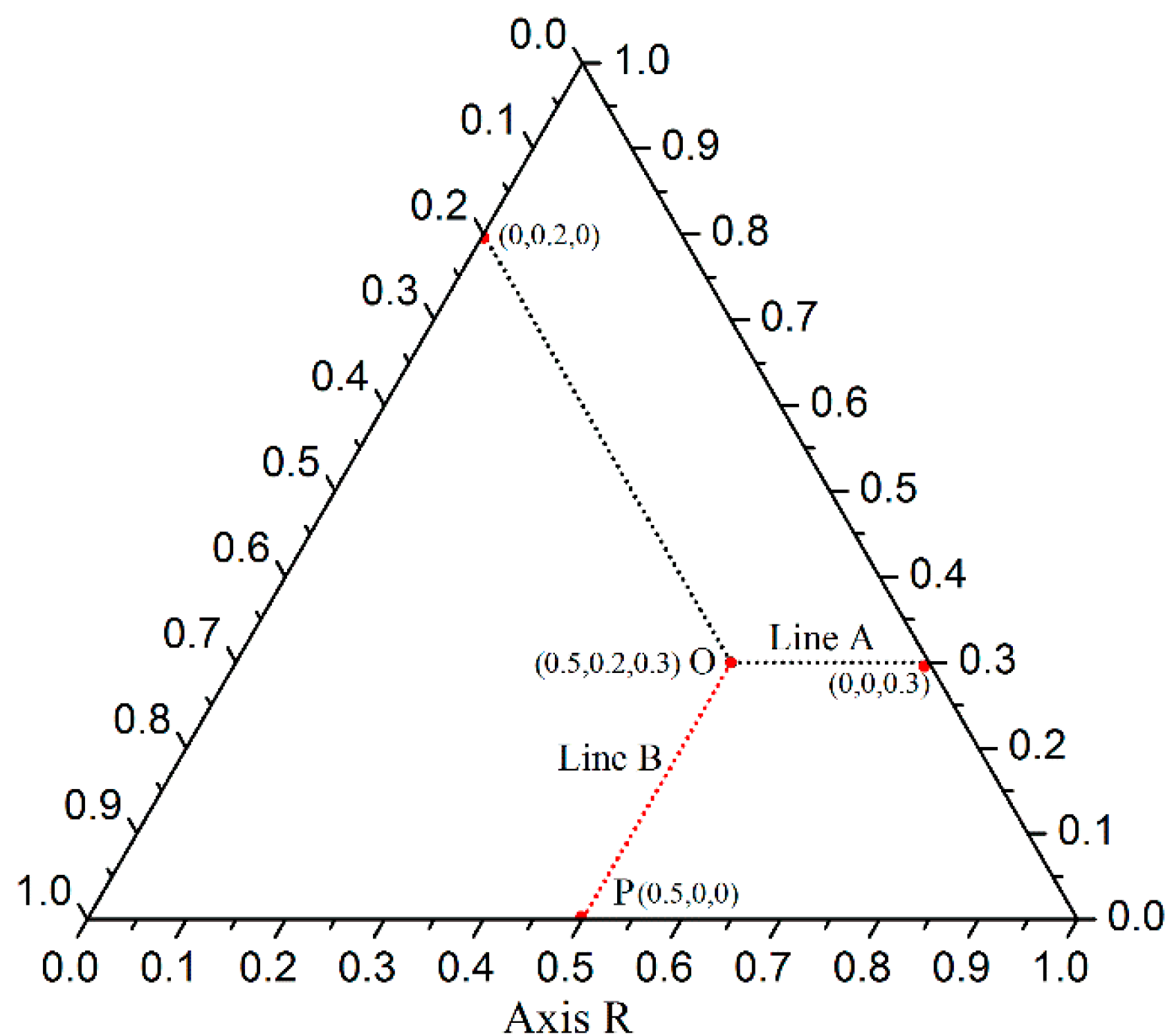
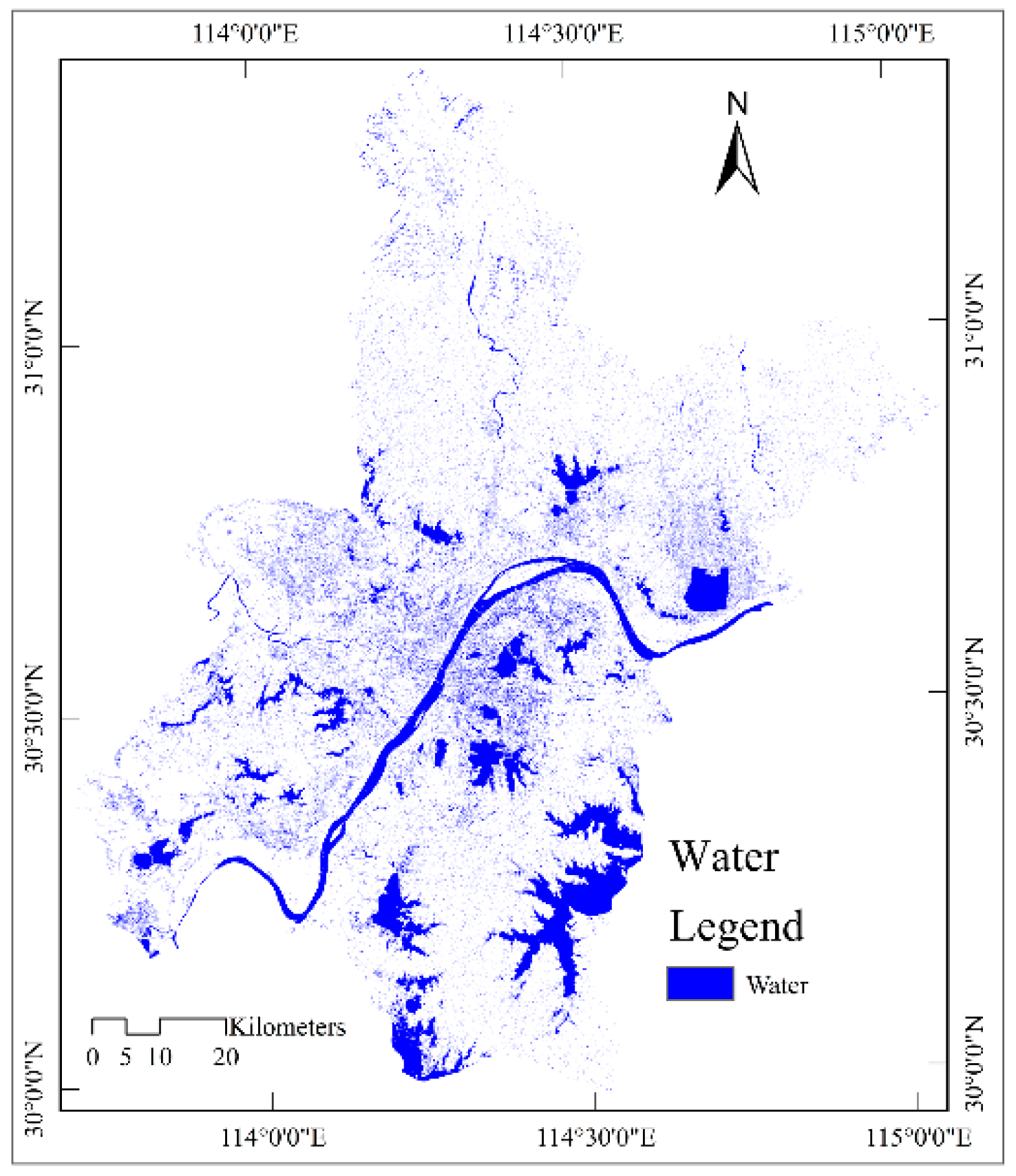
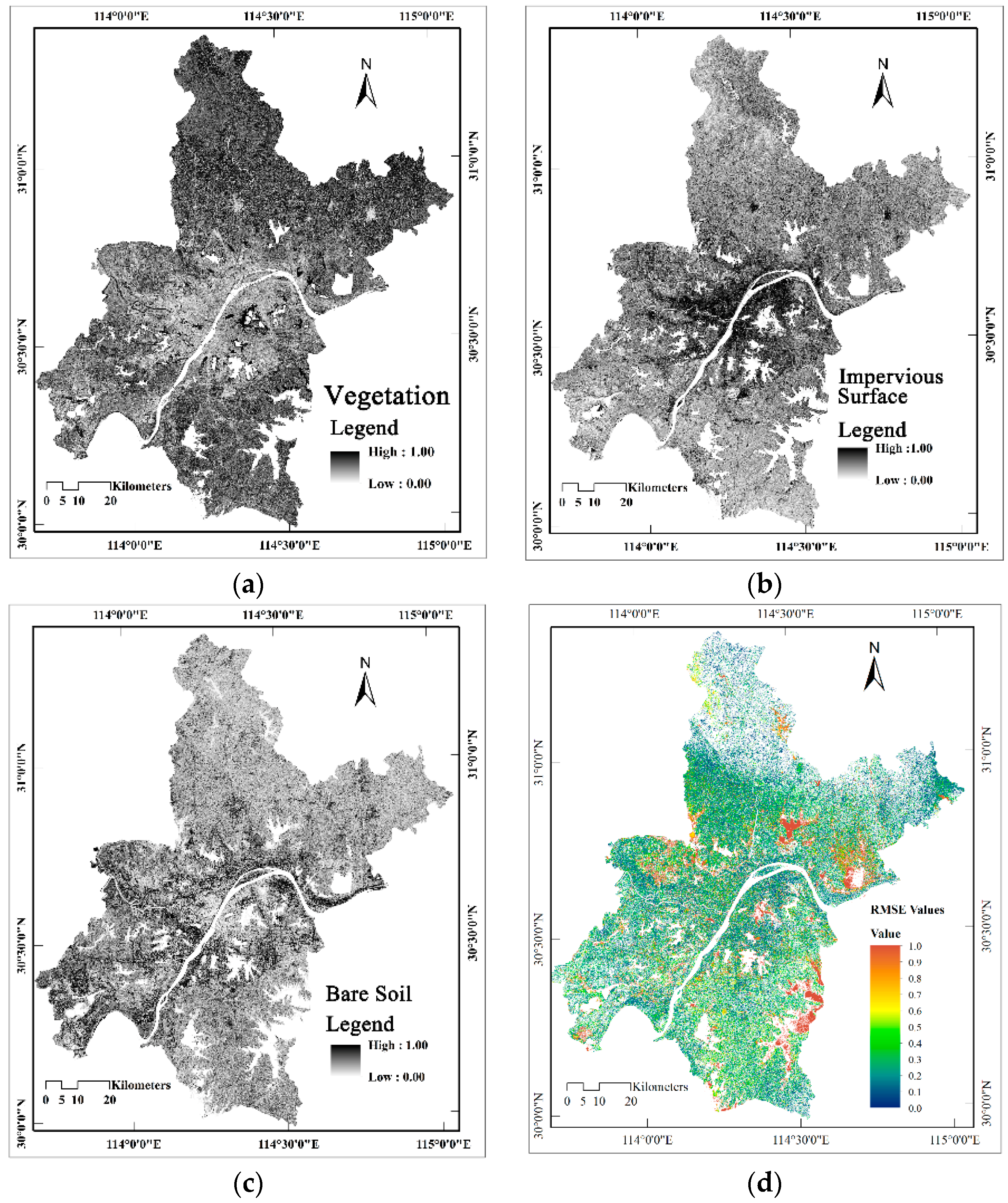
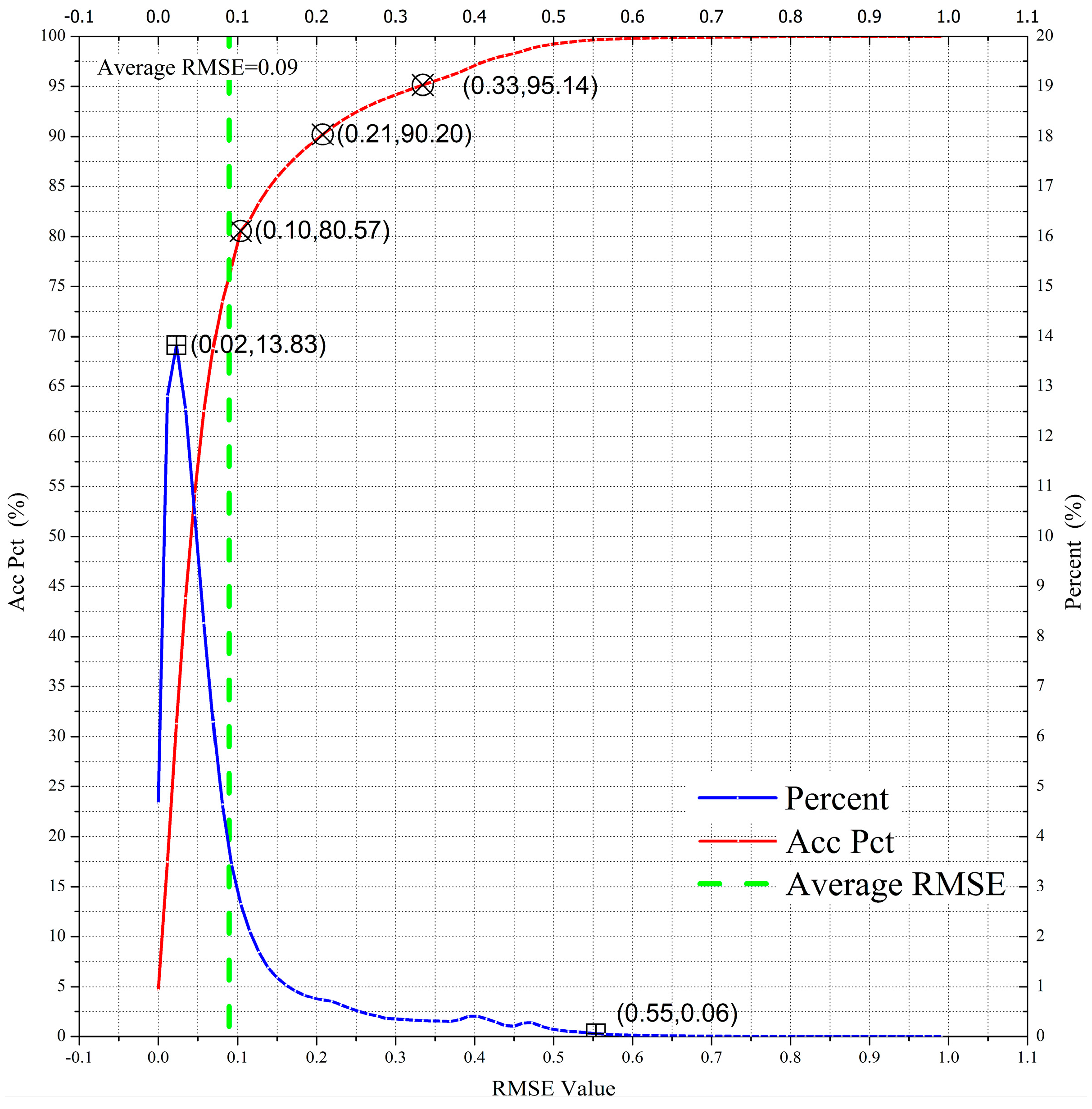
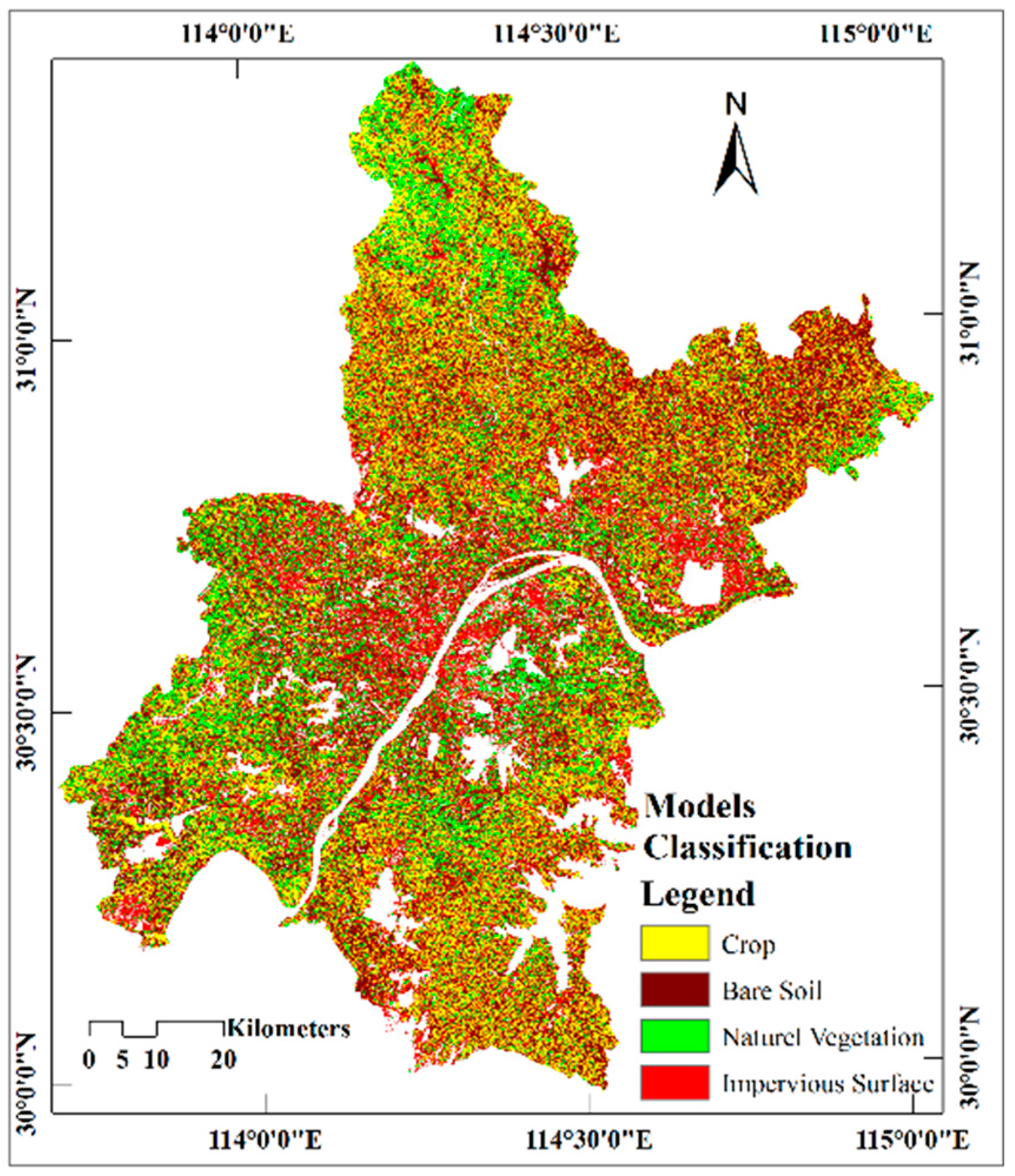
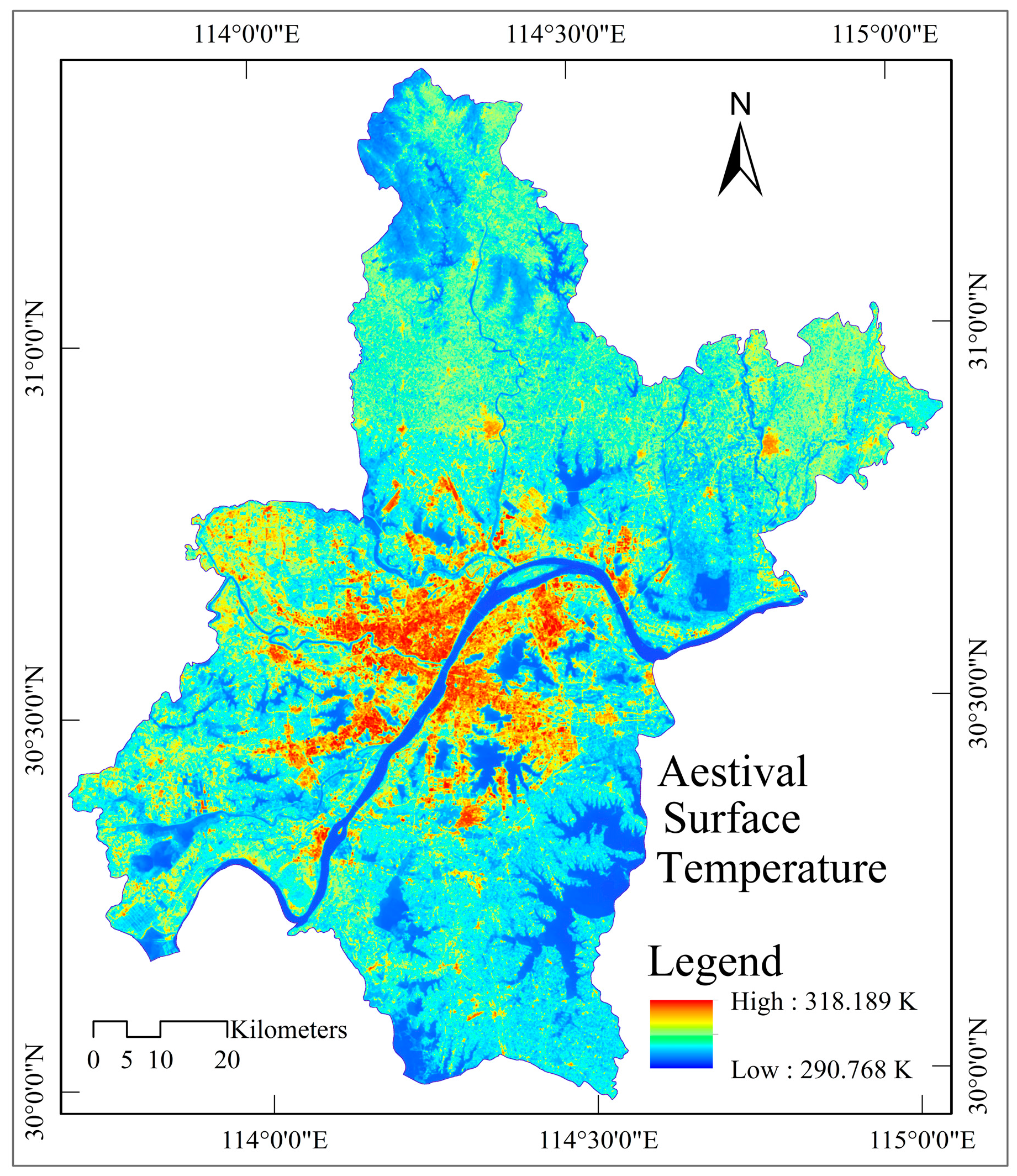
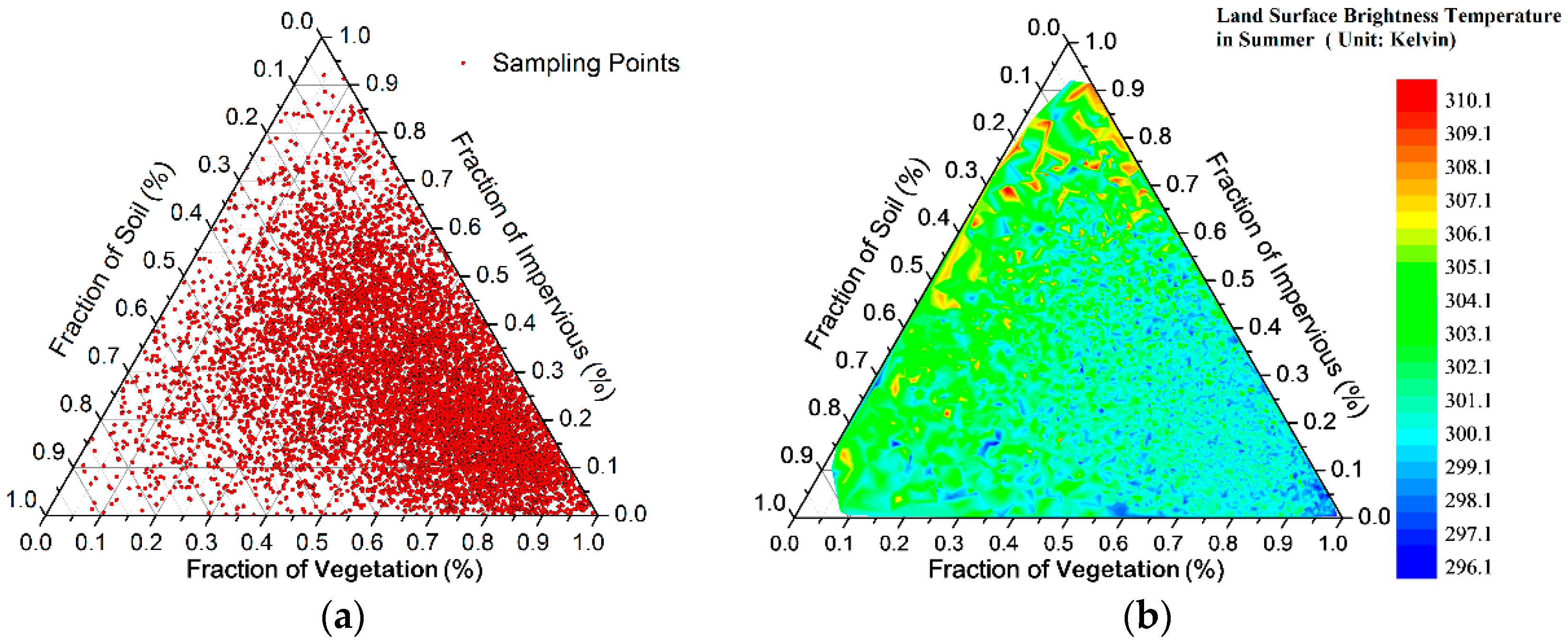

| Dates | Path/Row | File Name |
|---|---|---|
| 28 May 2013 | 123/038 | LC81230382013148LGN01 |
| 13 June 2013 | 123/039 | LC81230392013164LGN00 |
| 8 July 2013 | 122/039 | LC81220392013221LGN00 |
| Fitted | Adj. R2 | Prob > F | Prob > |t| | ||
|---|---|---|---|---|---|
| Vegetation Fraction | Impervious Fraction | Bare Soil Fraction | |||
| 8# | 0.880 | 1.443 × 10−15 | 1.554 × 10−15 | — | — |
| 9# | 0.902 | 1.11 × 10−16 | — | 0.00 | — |
| 10# | 0.986 | 0.00 | 0.362 | 6.531 × 10−8 | 0.002 |
© 2017 by the authors. Licensee MDPI, Basel, Switzerland. This article is an open access article distributed under the terms and conditions of the Creative Commons Attribution (CC BY) license (http://creativecommons.org/licenses/by/4.0/).
Share and Cite
Chen, T.; Zhang, X.; Niu, R. The Relationship between Urban Land Surface Material Fractions and Brightness Temperature Based on MESMA. Remote Sens. 2017, 9, 532. https://doi.org/10.3390/rs9060532
Chen T, Zhang X, Niu R. The Relationship between Urban Land Surface Material Fractions and Brightness Temperature Based on MESMA. Remote Sensing. 2017; 9(6):532. https://doi.org/10.3390/rs9060532
Chicago/Turabian StyleChen, Tao, Xujia Zhang, and Ruiqing Niu. 2017. "The Relationship between Urban Land Surface Material Fractions and Brightness Temperature Based on MESMA" Remote Sensing 9, no. 6: 532. https://doi.org/10.3390/rs9060532






